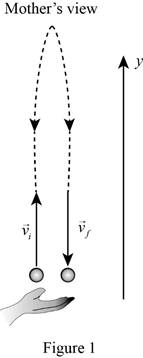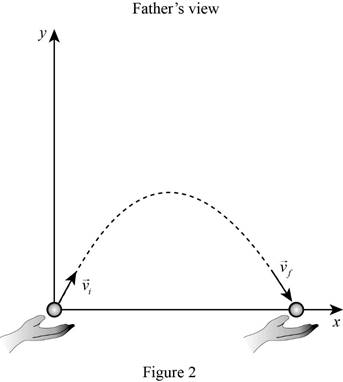
A mother pushes her son in a stroller at a constant speed of 1.52 m/s. The boy tosses a 56.7-g tennis ball straight up at 1.75 m/s and catches it. The boy’s father sits on a bench and watches.
a. According to the mother, what are the ball’s initial and final momenta?
b. According to the father, what are the ball’s initial and final momenta?
c. According to the mother, is the ball’s momentum ever zero? If so, when? If not, why not?
d. According to the father, is the ball’s momentum ever zero? If so, when? If not, why not?
(a)
The initial and final momentum of ball according to mother’s view.
Answer to Problem 4PQ
The initial momentum is
Explanation of Solution
Consider the figure showing the motion of ball on the basis of mother’s point of view.

According to mother’s point of view, the ball moves vertically upwards and falls vertically downwards with same speed. But initial momentum is in positive y direction and final momentum is in negative y direction.
Write the expression for initial momentum.
Here,
Write the expression for final momentum.
Here,
Conclusion:
Substitute,
Substitute,
Therefore, the initial momentum is
(b)
The initial and final momentum of ball according to father’s view.
Answer to Problem 4PQ
The initial momentum is
Explanation of Solution
Consider the figure showing the motion of ball on the basis of father’s point of view

The path of ball is now parabolic, horizontal velocity is same as those observed by mother, but vertical velocity is equal to the velocity of stroller.
Write the expression for initial momentum.
Here,
Write the expression for final momentum.
Here,
Conclusion:
Substitute,
Substitute,
Therefore, the initial momentum is
(c)
Whether the momentum of ball is zero ever according to mother.
Answer to Problem 4PQ
The momentum will be zero according to mother’s point of view.
Explanation of Solution
According to mother’s view the ball is in vertical motion. At maximum height the kinetic energy is completely converted to potential energy, and velocity of ball is zero, or ball is momentarily at rest.
Momentum is the product of mass and velocity, thus, if velocity is zero, momentum will be zero, at top of flight.
Conclusion:
Therefore, momentum will be zero, at maximum height according to mother’s view.
(d)
Whether the momentum of ball is zero ever according to father.
Answer to Problem 4PQ
The momentum is never become zero according to father’s view.
Explanation of Solution
The motion is parabolic according to father’s view, and has two components of velocity, horizontal and vertical. Even though vertical component become zero, at any point, the horizontal component remains same until the ball covers entire parabolic path.
Hence momentum will not be equal to zero.
Conclusion:
The total velocity is the sum of horizontal and vertical velocity, since horizontal velocity remains same as a nonzero value, momentum is never become zero.
Want to see more full solutions like this?
Chapter 10 Solutions
Bundle: Physics For Scientists And Engineers: Foundations And Connections, Volume 1, Loose-leaf Version + Webassign Printed Access Card For Katz's ... And Connections, Single-term Courses
- Sven hits a baseball (m = 0.15 kg). He applies an average force of 50.0 N. The ball had an initial velocity of 35.0 m/s to the right and a final velocity of 40.0 m/s to the left as viewed by a fan in the stands. a. What is the impulse delivered by Svens bat to the baseball? b. How long is his bat in contact with the ball?arrow_forwardA car crashes into a large tree that does not move. The car goes from 30 m/s to 0 in 1.3 m. (a) What impulse is applied to the driver by the seatbelt, assuming he follows the same motion as the car? (b) What is the average force applied to the driver by the seatbelt?arrow_forwardProblems 44 and 45 are paired. C A model rocket is shot straight up. As it reaches the highest point in its trajectory, it explodes in midair into three pieces with velocities indicated by the arrows in Figure P10.44, as viewed from directly above the explosion. Rank the mass of each piece in order from smallest to largest and justify your answer. FIGURE P10.44 Problems 44 and 45.arrow_forward
- In a laboratory, a cart collides with a wall and bounces back. Figure P11.10 shows a graph of the force exerted by the wall versus time. a. Find the impulse exerted by the wall on the cart. b. What is the average force exerted by the wall on the cart? c. If the cart has a mass of 0.448 kg, what is its change in velocity? d. Make a sketch of the situation. Include a coordinate system and explain the significance of the signs in parts (a) through (c). FIGURE P11.10arrow_forwardA pitcher claims he can throw a 0.145-kg baseball with as much momentum as a 3.00-kg bullet moving with a speed of 1.50 103 m/s (a) What must the baseballs speed be if the pitchers claim is valid? (b) Which has greater kinetic energy, the ball or the bullet?arrow_forwardA football player of mass 95 kg is running at a speed of 5.0 m/s down the field as shown in Figure P11.53. A second player of mass 140 kg, running at a speed of 2.5 m/s, tackles the first player so that they move together after the collision. What is the velocity of the two players immediately after the collision? FIGURE P11.53 53. The football players have the same final velocity in this inelastic collision. We can use Equations 11.24 and 11.25 to determine the x and y components of the final velocity. The lighter player (95 kg) moves vertically, so v1ix = 0 and v1iy = 5.00 m/s. The other player (140 kg) moves to the right, so v2ix = 2.5 m/s and v2iy = 0. Therefore, m1v1ix+m2v2ix=(m1+m2)vfx(140kg)(2.5m/s)=(95kg+140kg)vfxvfx=1.5m/sm1v1iy+m2v2iy=(m1+m2)vfy Chapter 11 Collisions11.31 (95kg)(5.00m/s)=(95kg+140kg)vfyvfy=2.0m/s The final velocity is then vf=(1.5i+2.0j)m/sarrow_forward
- The space shuttle uses its thrusters with an exhaust velocity of 4440 m/s. The shuttle is initially at rest in space and accelerates to a final speed of 1.00 km/s. a. What percentage of the initial mass of the shuttle (including the full fuel tank) must be ejected to reach that speed? b. If the mass of the shuttle and fuel is initially 1.85 106 kg, how much fuel is expelled?arrow_forwardSand from a stationary hopper falls onto a moving conveyor belt at the rate of 5.00 kg/s as shown in Figure P8.64. The conveyor belt is supported by frictionless rollers and moves at a constant speed of v = 0.750 m/s under the action of a constant horizontal external force Fext supplied by the motor that drives the belt. Find (a) the sands rate of change of momentum in the horizontal direction, (b) the force of friction exerted by the belt on the sand, (c) the external force Fext, (d) the work done by Fext in 1 s, and (e) the kinetic energy acquired by the falling sand each second due to the change in its horizontal motion. (f) Why are the answers to parts (d) and (e) different? Figure P8.64arrow_forwardA model rocket engine has an average thrust of 5.26 N. It has an initial mass of 25.5 g, which includes fuel mass of 12.7 g. The duration of its burn is 1.90 s. (a) What is the average exhaust speed of the engine? (b) This engine is placed in a rocket body of mass 53.5 g. What is the final velocity of the rocket if it were to be fired from rest in outer space by an astronaut on a space-walk? Assume the fuel burns at a constant rate.arrow_forward
- a man of mass m1 = 70.0 kg is skating at v1 = 8.00 m/s behind his wife of mass m2 = 50.0 kg, who is skating at v2 = 4.00 m/s. Instead of passing her, he inadvertently collides with her. He grabs her around the waist, and they maintain their balance. (a) Sketch the problem with before-and-after diagrams, representing the skaters as blocks. (b) Is the collision best described as elastic, inelastic, or perfectly inelastic? Why? (c) Write the general equation for conservation of momentum in terms of m1, v1, m2, v2, and final velocity vf. (d) Solve the momentum equation for vf. (e) Substitute values, obtaining the numerical value for vf, their speed after the collision.arrow_forwardA 5-kg cart moving to the right with a speed of 6 m/s collides with a concrete wall and rebounds with a speed of 2 m/s. What is the change in momentum of the cart? (a) 0 (b) 40 kg m/s (c) 40 kg m/s (d) 30 kg m/s (e) 10 kg m/sarrow_forwardA ball of mass 50.0 g is dropped from a height of 10.0 m. It rebounds after losing 75% of its kinetic energy during the collision process. If the collision with the ground took 0.010 s, find the magnitude of the impulse experienced by the ball.arrow_forward
 Physics for Scientists and Engineers: Foundations...PhysicsISBN:9781133939146Author:Katz, Debora M.Publisher:Cengage Learning
Physics for Scientists and Engineers: Foundations...PhysicsISBN:9781133939146Author:Katz, Debora M.Publisher:Cengage Learning Principles of Physics: A Calculus-Based TextPhysicsISBN:9781133104261Author:Raymond A. Serway, John W. JewettPublisher:Cengage Learning
Principles of Physics: A Calculus-Based TextPhysicsISBN:9781133104261Author:Raymond A. Serway, John W. JewettPublisher:Cengage Learning College PhysicsPhysicsISBN:9781285737027Author:Raymond A. Serway, Chris VuillePublisher:Cengage Learning
College PhysicsPhysicsISBN:9781285737027Author:Raymond A. Serway, Chris VuillePublisher:Cengage Learning Glencoe Physics: Principles and Problems, Student...PhysicsISBN:9780078807213Author:Paul W. ZitzewitzPublisher:Glencoe/McGraw-Hill
Glencoe Physics: Principles and Problems, Student...PhysicsISBN:9780078807213Author:Paul W. ZitzewitzPublisher:Glencoe/McGraw-Hill Physics for Scientists and Engineers, Technology ...PhysicsISBN:9781305116399Author:Raymond A. Serway, John W. JewettPublisher:Cengage Learning
Physics for Scientists and Engineers, Technology ...PhysicsISBN:9781305116399Author:Raymond A. Serway, John W. JewettPublisher:Cengage Learning Physics for Scientists and Engineers with Modern ...PhysicsISBN:9781337553292Author:Raymond A. Serway, John W. JewettPublisher:Cengage Learning
Physics for Scientists and Engineers with Modern ...PhysicsISBN:9781337553292Author:Raymond A. Serway, John W. JewettPublisher:Cengage Learning





